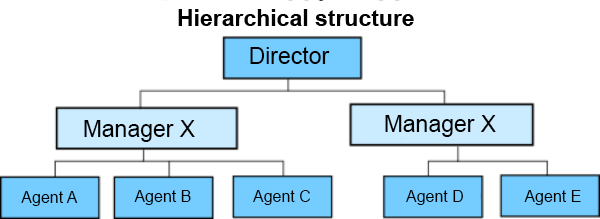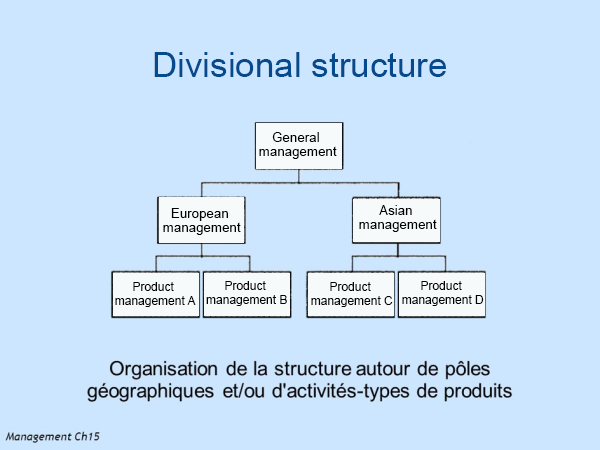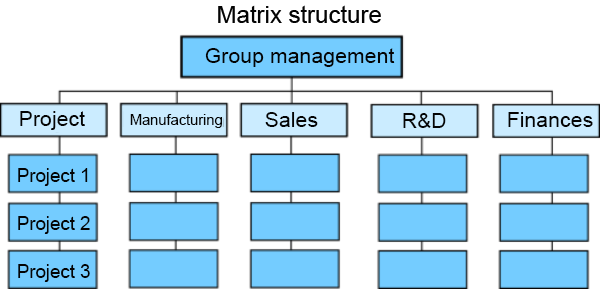A company’s organisational structure is more than just an organisational chart; it is the backbone that supports the company’s vision, mission, and objectives. This structure influences not only the company’s overall performance but also the well-being of each employee.
However, each type of organisational structure has its own advantages and disadvantages, making the choice of an appropriate structure crucial for the company’s success. The dilemma then arises: which organisational model should be adopted to maximise the performance of your organisational intelligence while minimising inefficiencies?
Business organisational structures are management tools for organisations. One of the most well-known is the organisational chart.
What is an organisational structure?
An organisational structure is the way a company is organised to produce efficiently. In other words, the organisation of a company represents the hierarchical and functional working relationships between the various employees and entities.
Why is a company’s organisational structure important?
An organisational structure is essential for both employees and the smooth running of the company.
For employees, it provides benchmarks and helps them understand their roles within the organisation.
For the company, it helps define the resources needed and organise them effectively to achieve production objectives. In the case of reorganisation, it can help identify opportunities to be exploited.
There are different styles of organisational structure, and each model has its own advantages and disadvantages.
Which type of organisational structure for which organisation?
Not all types of organisational structures are applicable to all organisations. Some types will be more effective for certain organisations and ineffective for others. This is why it is important to know them to determine which ones best suit your entity.
Organisational structures evolve with the company and its objectives
Over its lifetime, the organisation may move from one type of structure to another depending on its growth and strategy.
For over 10 years, we have been working daily with a wide variety of companies. In this article, we have chosen to present the 5 different types of organisational structures that we most commonly encounter.
The 5 main types of organisational structure
These 5 structures are presented in increasing order, from the simplest to the most complex. Indeed, the larger the company, the more an elaborate organisational structure will be suitable.
1) The hierarchical structure
2) The functional structure
3) The divisional structure
4) The staff and line structure
5) The matrix structure (or project-based structure)
The hierarchical structure
This type of organisational structure is the most common. It is also the most classic and well-known organisational chart.
The levels of managers and employees are represented to visualise each person’s role.
Description of the hierarchical structure
The hierarchical structures proposed by Henry Fayol are based on the principle of unity of command in work, according to which, in an organisation, each employee depends on only one hierarchical superior:
- Each individual is responsible for all those placed below them in the organisation.
- Each worker knows only one boss.
- Each department head is responsible only for the work carried out in their department and has authority only within their department.

Which hierarchical structure for which size of company?
The hierarchical structure is suitable for both very small business (VSB) and small and medium-sized business (SMB).
Advantages of this organisational structure
- Simple operation,
- Clear and precise distribution of activities and responsibilities,
- Flawless discipline towards management.
Disadvantages of this organisational structure
- Rigid organisation,
- Difficult implementation and rather slow communication, which can hinder initiative and project-based operation.

5 main types of organisational structure

The functional structure
In functional structures (also called U-structures), each manager is specialised according to their type of skills. Thus, each department head has authority over their subordinates within the limits of their specific function. A single employee may therefore have several specialised managers.
Description of the functional structure
In the functional structure, resources and skills are distributed by function. To better understand, we can cite, for example, the communication function/specialist, the finance function/specialist, the marketing function/specialist, or the accounting function/specialist.

The functional structure for which size of company?
The functional structure is most commonly used in medium-sized companies with a single activity.
Advantages of this organisational structure
- Diversity of advice from different specialists,
- Better quality of task execution, even the most specialised,
- Greater productivity.
Disadvantages of this organisational structure
- Risk of conflicts and dilution of power,
- Lack of error traceability.
The divisional structure
Divisional structures are an organisational model adopted by companies operating in multiple business areas and markets (local and foreign).
Description of the divisional structure
The company is organised into distinct divisions or profit centres (specific activity, particular geographic area, customer segment). Each division is an autonomous organisation with its own activities, organisational chart, resources, and functional structure. It has extensive powers over its products and markets.

This type of organisation is also called the M (Multidivisional) structure.
In organisations of this type, support functions (central services) can share their expertise with the operational functions of all divisions.
The divisional structure for which size of company?
The divisional structure is very useful for large companies with diversified activities.
Advantages of this organisational structure
- Decision-making autonomy of divisions,
- Common product culture within a single division,
- Adaptability of the structure,
- Easier measurement of division performance.
Disadvantages of this organisational structure
- Greater difficulty in establishing a global company culture,
- Redundancy of positions,
- More difficult to implement economies of scale,
- Costly sharing of resources across multiple divisions
The “staff and line” or “hierarchical and functional” structure
In staff and line structures, also called hierarchical-functional organisations (or structures), there coexist:
– the line, a functional and hierarchical system based on a pyramidal model,
– and the staff, a headquarters under the authority of a chief, which advises line executives, supervises and coordinates their activity, and imposes strategic decisions on them.
Description of the staff and line structure
A staff and line structure is therefore a mixed form between the functional and hierarchical structures of companies.
It is essentially based on the hierarchical principle of unity of management and on the use of advisory bodies composed of specialists: hierarchical managers benefit from the assistance of advisors for specific areas of activity. The overall strategic decisions are made by the directors, and the functional managers are there to contribute to and optimise them according to the speciality related to each department.
A hierarchical and functional structure is organised around a line of management and decision-making power (operational directors) and a line of advice and assistance (functional directors).

The staff and line structure for which size of company?
The staff and line structure is suitable for medium-sized companies specialising in various fields of activity.
Advantages of this organisational structure
- It allows the manager and directors (line) to benefit from the assistance of specialists (staff),
- There is always only one boss, i.e., a unity of command, making it a clear structure.
Disadvantages of this organisational structure
- It can create conflicts between the management functions assumed in the line vs. those assumed by the staff.
The matrix structure (or Project-Based Structure)
The matrix structure organises the company’s activities (or projects) by combining specialisations. It allows certain managers to combine two types of responsibilities within the organisation: an operational responsibility (e.g., a product) and a functional or geographic responsibility (e.g., a country). Other combinations are possible, such as function & product, technology & product, function & project, etc.
Description of the matrix structure
The matrix structure is suitable for diversified companies that often operate in project mode and wish for greater collaboration between the divisions of their organisation. It is also suitable for internationalised companies, facilitating a global approach and local adaptation.

Boeing was the first company, over 40 years ago, to adopt a matrix structure. Its units belong to both their specialty branch (wings, guidance systems, etc.) and their programme department (by type of aircraft: 737, 757, 767, etc.).
The matrix structure for which size of company?
The matrix structure is used in large companies with multiple activities that need to manage many projects in a rapidly changing context.
Advantages of this organisational structure
- Risk of conflicts and communication problems,
- Unsuitability for large companies with decentralised activities. Decision-making circuits can become very long.
- Without a unity of command, it can sometimes be difficult to make a decision or reach a compromise.
- Challenging the principle of hierarchy can lead to many conflicts between managers and thus hinder the implementation of the strategy.

More than just an organisational chart

4 characteristics of organisational structure
- Importance of choosing the right structure
The organisational structure is essential for the smooth running of a company. It influences the hierarchy, responsibilities, and even the company culture. Therefore, choosing the right structure is crucial for achieving the company’s objectives. - Flexibility and evolution
A company is not static; its structure can evolve over time. For example, a very small business might start with a simple hierarchical structure and evolve into a matrix structure as it diversifies. It is therefore important to periodically reassess the relevance of the existing organisational structure. - Matching size and type of structure
Each type of organisational structure has its own advantages and disadvantages, and some are better suited to certain sizes of companies. For example, functional structures often suit medium-sized companies, while matrix structures are more suitable for large, diversified companies. - Risks and disadvantages
Although each organisational structure has its advantages, they all have their own disadvantages, such as the risk of conflicts, slow communication, or unsuitability. These factors must be carefully considered when selecting an organisational structure.
Contact us
Write to usFollow us on Linkedin
Follow usAller plus loin
Different types of organisational charts: definition and uses
Organisational chart: a visual tool for structuring and understanding an organisation...
Organisational structure: definition, advantages, and disadvantages of different business structures
Organisational structure: key to performance and adaptability. ...

